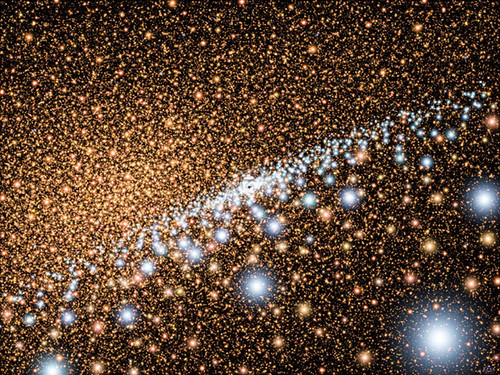1) Black holes succor!
So we live in a spiral galaxy, right? That means it’s a flat disk, with spiral arms, a bulge of stars in the middle, and right at the center sits a black hole – all big galaxies appear to have one. The monster in our middle tips the cosmic scales at over 4 million times the mass of the Sun. That sounds like a lot, but remember there are about 200 billion stars in the Milky Way, so in reality the black hole is 0.002% of the mass of the galaxy, more or less.
 |
| Artist’s concept of young stars near the galactic center. Credit: NASA, ESA, and A. Schaller (for STScI) |
Near the black hole, you’d think the environment is not exactly nurturing. The gravity of the hole is enormous, of course. Stars can orbit it in stable paths that last for billions of years, but big objects like gas clouds can be shredded; the black hole pulls on one side more strongly than the other, which can tear the clouds apart.
So we don’t expect to see young stars near the very center of the Milky Way – yet that is precisely what astronomers have found using the radio telescopes in the Very Large Array in New Mexico!
Young stars being born cry out in radio wavelengths, and the VLA is exceptional at precisely pinpointing post-partum protostars. The astronomers found two such young stars still in the act of forming. Incredibly, this means their cocoon of gas must survive being so close to the black hole – in this case, just seven and ten light years away! Since most gas clouds are light years across, this means these clouds must be smaller and more dense than usual.
This study means that stars can form in relatively hostile environments, and that in turn tells more about how stars form, which is cool, and what things are like very close to the maw of the supermassive black hole lurking at the galactic center, which is very cool indeed.
2) Our Galaxy is beefier than thought
Sitting as we do off to one side of the Milky Way, it’s really hard to get a good census of it. Dust clouds block our view, for example, and the Sun is rushing around the center of the galaxy along with the hundreds of billions of others.
 |
| Map of the galaxy, showing the center, the arms, and the locations of the gas clouds used to get the data. Our location is the red dot. Credit: Robert Hurt, IPAC; Mark Reid, CfA, NRAO/AUI/NSF |
The speed of the Sun depends on the combined mass of all the stars, gas, and dust between us and the center. The gravity of all that stuff is what determines our speed. If we’re moving faster than we thought, then the galaxy itself must be more massive. This increase in speed indicates the Milky Way is actually 50% more massive than we previously thought!
That’s a big difference. That means we’re the equal of the Andromeda Galaxy, which we thought was the big boy of the local collection of galaxies. Now we don’t have to hang our head in shame any more.
Even cooler, the astronomers discovered the Milky Way appears to have four spiral arms, and not just two!
So we’re as massive as Andromeda, and we have four arms. Hmmmm. The obvious conclusion: we can easily take Andromeda on and beat it up! In a couple of billion years, we’ll get our chance, when the two galaxies collide and eventually merge. Sadly, after that, we’ll most likely be an elliptical puffball galaxy, with no arms at all. But until then, it looks like we’re king of the hill.